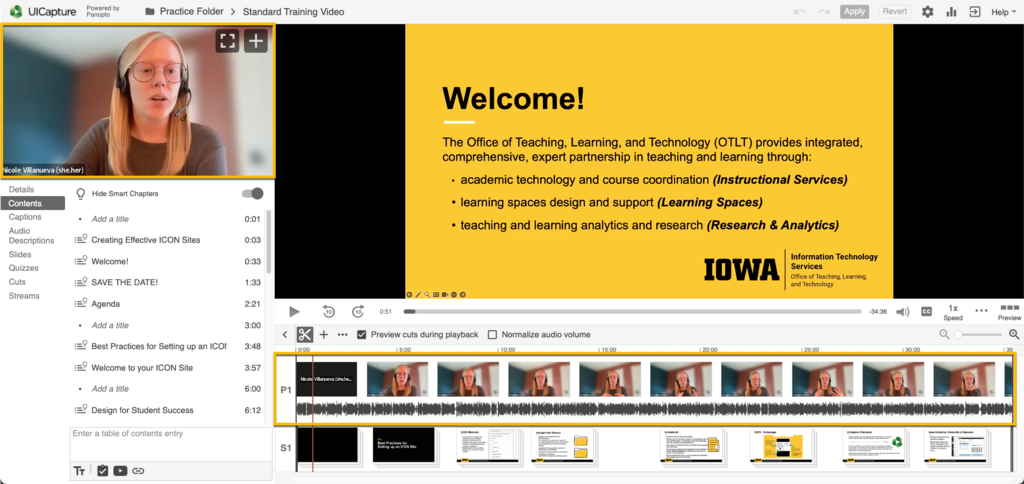FERPA and PII Considerations
Federal law protects the privacy of student education and academic records and prohibits the dissemination of this and other personal identifying information (PII) without the prior consent of the individual. For more information, see the Office of the Registrar’s FERPA page and the IT Security and Policy Office’s Protecting Personal Identifiable Information page.
UICapture Streams
Videos that are either recorded directly in UICapture or recorded in Zoom and are then transferred over to UICapture generally contain a variety of outputs. The Primary Stream is visible in the top left-hand corner. This stream is generally a view of the main speaker’s camera along with any audio recorded by the main speaker. In the UICapture editor, this stream appears at the top of the timeline, as indicated by the “P1.” Any video and audio information contained within this stream cannot be independently edited or removed. Please see Redacting identifying information from Primary Streams below to learn how to work around removing any identifying information recorded within a Primary Stream.

The Secondary Stream often contains PowerPoint slides, screen shares, and/or other supplementary media. Videos recorded in Zoom often result in a Secondary Stream containing the participants’ video thumbnails. Please see Redacting identifying information from Secondary Streams to learn how to work around removing any identifying information recorded within a Secondary Stream.
Considerations when recording
If you would like to record a video lecture for future classes and semesters, it is ideal to do so without students or audience members present. Creating a clean version of the lecture recording in which you are the only member present in the Zoom room will keep identifying information of others out of the recording.
If you plan to use a recording of a live course lecture with student participants, one way to work around potentially recording identifying information is to ask that students or attendees mute their microphones. In this scenario, students’ videos should not appear in the Primary Stream. If their videos appear in the Secondary Stream, this stream can easily be deleted altogether to redact the information.
Considerations for pre-recorded videos
Redacting identifying information from the video description
Videos that have already been recorded in Zoom and stored within UICapture often contain the names of attendees. To ensure that no identifying information is stored within the video description:
- Navigate to the video editor by hovering over the video within UICapture and clicking Edit
- Click on the Settings gear icon in the top right-hand corner of the video editor
- Click on Edit below Description in the Overview tab
- Remove any names of students or other identifying information
- Click Save
If using the Canvas course copy feature or copying a UICapture folder to a new folder, make sure that no identifying information within these videos are available in the new Canvas course or UICapture folder.
Redacting identifying information from the Primary Stream
If a video recorded in Zoom contains instances of students or audience members speaking, their video thumbnails, which often contain their name and/or other identifying information (such as pronouns), may appear in the Primary Stream window. In these instances, the Primary Stream should be downloaded as an audio-only file and then re-uploaded so that the original stream containing video information can be deleted. This will assure that no visually identifying information is available in the pre-recorded lecture video.
- Navigate to the video editor for that video
- Click on the Settings gear icon in the top right-hand corner of the video editor
- Access the Outputs tab within the Settings dialogue box
- Scroll down to Audio Podcast and click Download Audio Podcast
- 5. Close out of the Settings dialogue box
- 6. Click on Streams in the left-hand menu of the video editor
- 7. Click Add Streams
- 8. Browse for the downloaded audio file or drag and drop the file from your device into the Upload primary audio or video section of the video editor page
- 9. There will now be two instances of audio in the timeline: one with the first Primary Stream (P1) and one within the second Primary Stream (P2)
- 10. Delete the Primary Stream that contains both video and audio information (P1) by hovering over that stream, clicking the three dots alongside the stream name, and clicking Delete.
- Only the Primary Stream containing the audio (P2) will be retained along with any Secondary Streams for the video
Redacting identifying information from the Secondary Stream
As a reminder, videos recorded in Zoom often result in a Secondary Stream containing the participants’ video thumbnails. To redact identifying information from a specific stream, users can trim an individual stream and make more accurate cuts.
Alternatively, to completely remove Secondary Streams that hold identifying information:
- Navigate to the video editor
- Click on Streams in the left-hand menu of the video editor
- Delete the Secondary Stream that contains identifying information by hovering over that stream, clicking the three dots alongside the stream name, and clicking Delete